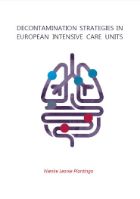Nienke Plantinga
Decontamination Strategies in European Intensive Care Units

- Datum
- (Co) promotoren
- 19-06-2018
- prof.dr. M.J.M. Bonten
Samenvatting
Patients admitted to the intensive care unit (ICU) are at risk for acquisition of healthcare associated infections. These infections are often anticipated by overgrowth of potentially pathogenic micro-organisms (PPMO). Several decontamination strategies aim to prevent overgrowth of these PPMO in the respiratory tract, gastro-intestinal tract or both. These include selective decontamination using antibiotics (SDD and SOD) and chlorhexidine mouthwash (CHX). This thesis aims to determine the effects of different decontamination strategies on patient outcomes and the occurrence of antibiotic resistant bacteria in European Intensive Care Units (ICU) with low and higher prevalence of antibiotic resistance. Several research questions have been answered for ICUs with low levels of antibiotic resistance, using data from high-quality registries (“MARS-cohort”, “NICE-registry”) and in an individual participant data meta-analysis (IPD-MA) of randomized studies. The main study underlying this thesis is a new cluster randomized trial performed in 13 European ICUs with higher levels of antibiotic resistance (the “R-GNOSIS ICU study”). That overgrowth of PPMO indeed plays a role in the development of ICU-acquired infections was confirmed in this thesis, where gastro-intestinal overgrowth with Gram-negative bacteria was associated with the acquisition of infections, blood stream infections and overgrowth in the respiratory tract with the same class of micro-organisms, in a cohort study with more than 2000 patients. The beneficial effects of SDD and SOD on patient survival and the acquisition of blood stream infections in Dutch ICUs were already known prior to this thesis. In this thesis, an IPD-MA of more than 17,000 ICU-admissions resulted in the finding that both surgical and medical ICU patients – which are two distinct groups with regard to disease severity and prognosis – both benefit from these treatments, with SDD being more effective than SOD at reducing in-hospital mortality. On the contrary, the R-GNOSIS ICU study, in which >8500 patients participated, did not demonstrate any beneficial effect of SDD, SOD or CHX on the occurrence of ICU-acquired blood stream infections in countries with higher prevalence of antibiotic resistance. Despite two temporary outbreaks with antibiotic resistant bacteria during the use of SOD, on average no single strategy lead to an increase in the unit-wide prevalence of antibiotic resistant bacteria. SDD, and to a lesser extent SOD, were more effective than CHX or standard care at eradicating overgrowth with certain antibiotic resistant bacteria in patients that carried these micro-organisms from the initial stay in the ICU. Finally, one methodological study was conducted, to investigate how to correct for confounding by disease severity in multicenter ICU studies, when different centers use different measures to quantify disease severity. This simulation study lead to many different results. First and foremost, ignoring differences in disease severity measures in the statistical analysis may lead to large relative bias. Several statistical approaches are possible to reduce this bias, and the performance of these methods highly depends on the type and availability of different measures across centers.
